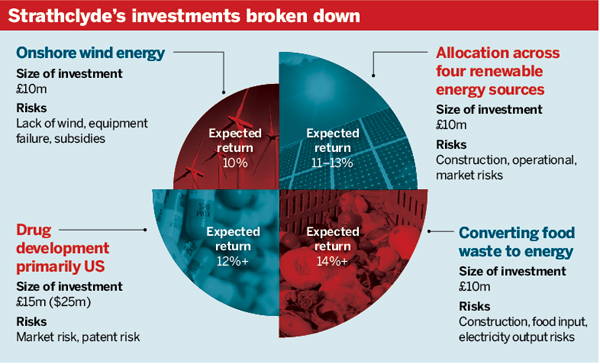Strathclyde Pension Fund has removed the £300m maximum from its New Opportunities portfolio, and will review its 3 per cent allocation limit, as it makes a suite of diversifying investments predominantly in renewable energy.
Institutional investors are increasingly picking funds that make a positive social impact, from West Midlands Pension Fund's £40m for small local businesses to Waltham Forest Pension Fund's £20.8m for healthcare, education and housing projects.
Strathclyde’s investments (see graphic) largely centre on solar, wind and food waste energy, as well as a US healthcare allocation, but all have a target net internal rate of return of more than 10 per cent.

“The portfolio as a whole is largely a diversification play,” said Richard McIndoe, head of pensions at the £13.9bn fund. “The individual investments will have different drivers.”
McIndoe added: “In this portfolio we do have a preference for investments with a positive impact, but the risk/return fundamentals come first.”
Pension funds often view these kinds of investments as a subset of infrastructure. Toby Buscombe, global head of infrastructure at consultancy Mercer, said it describes such investments as a “defensive diversifier”.
“We are generally encouraging clients to think about it as part of a broad and more diversified infrastructure strategy,” he said.
Investment experts argue more common renewable sources such as photovoltaic solar energy and onshore wind have built up track records, as well as environmental data that can guide experts in predicting future return drivers.
Ominder Dhillon, head of distribution at alternative energy manager Impax Asset Management, said: “Over time you can get a reasonable forecast for what the wind factor will be. There will be some variability around that year to year, but over a three to five-year period you should be pretty close to the central projections.”
Proven record
Investment experts underline that these investments have built up a track record. Buscombe said: “These technologies have been around actually for quite a long time. There are managers now in the market on their second or even third-generation funds.”
But the consultancy stressed to schemes the importance of specialist knowledge. “We are cautious of generalists across alternative investments.”
One of the key risks in this sector is construction risk, which Strathclyde is taking in its allocation of £10m in energy company Albion Community Power.
The scheme highlighted in its investment proposal that the level of this risk will vary across technologies, comparing the construction of a small hydro scheme with a wind turbine.
Impax, which runs two funds that take construction risk, relies on construction experts on the ground tracking progress. “The fund manager doesn’t physically get a hard hat on and do it himself,” said Dhillon.
Another risk in these investments that deters investors is regulatory change as political will shifts, but managers play this down.
“The government here has been very careful to grandfather existing infrastructure assets,” said Dhillon.
Membership profile
Strathclyde also saw an increase in active members of 6 per cent to 87,197 at the end of March, which it largely attributed to auto-enrolment, and which has halted its previously declining membership.
“We’re not yet sure that has reversed but it seems at least to have levelled off,” said McIndoe. But it is not currently affecting the scheme’s investments, he added, saying: “Our liquidity profile has always allowed us to invest for the long term.”














